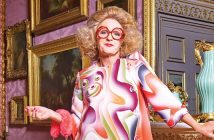When someone mentions British 20th century sculpture, chances are it’s Barbara Hepworth’s curvaceous, pierced forms that spring to mind. Instantly recognisable and much celebrated, they put her up there alongside Henry Moore’s recumbent figures as a national treasure.
The three curators of Tate Britian’s latest retrospective, Barbara Hepworth: Sculpture for a Modern World, have nonetheless sought to bring some fresh perspectives, conscious of not merely re-staging the Tate St Ives’ 2003 centenary show, nor the last big Hepworth show in London back in 1968 (which she was alive to take part in). This time round they make the case for the Yorkshire-born artist’s international influence. Often portrayed as working in isolation in her St Ives studio, the Cornish coast and moorlands as her sole inspiration, they have sought to highlight her engagement with the wider European avant-garde, and the way she shaped her image in this broader arena.
Direct carvings made when Hepworth was in her mid twenties are the earliest works on display. These small animal and human figures are placed alongside similar carvings by her contemporaries – and though pieces by Jacob Epstein and Henry Moore count among them, just as many are by obscure female sculptors whose work was intended as ornamentation for modern flats. This is where the curators set out to expose the first modern art myth: that direct carving was not the preserve of a handful of renegade modernists seeking to find truth in more primitive techniques – the way that Hepworth and Moore liked to portray it – but in fact had been used by many decorative artists, often to more prosaic, decorative ends. What really shines in this first section, whatever the various artistic intentions, is the beauty of the natural materials used – a lapis lazuli butterfly, green onyx toad, and seated girl in speckled fossil stone all diverge brilliantly from the uniform white marble of classical sculpture studied in art academies of the day. We also see the first hints of Hepworth’s evolution towards abstraction in the increasingly simplified trunks of her carved figures.
The sense of clear creative dialogue really gets going when she falls in love with the painter Ben Nicholson in 1931. Personal photo albums recently discovered in the family archives show the couple working closely together in a Hampstead studio, photographing each other with their art, and even exhibiting together. The same incised, intertwining profiles stare from his paintings and her sculptures. Travelling together to the Continent they met some of the biggest artistic names of the day (including Picasso, Brancusi, Arp and Kandinsky), took part in anti–fascist exhibitions, and appeared in international art publications such as Abstraction-Creation. And before long they found the avant-garde decamping to their own doorstep here in London, as the growing Nazi threat forced many artists to relocate across the Channel. Mondrian was one of the creative for whom the couple helped find accommodation here in London.
What soon emerges from the exhibition is the hand Hepworth had in shaping her self-image. Keenly aware of power of media and image to stimulate interest in her work, she tells editors how she wanted her work to be portrayed, meticulously catalogues every photograph that’s taken of her work, and edits articles. A series of collages where photos of her sculptures have been cut and pasted onto images of modern architecture, including buildings by Marcel Breuer, seem to be a calling card for civic and domestic commissions, effectively saying ‘look how my sculpture enhances your building.’
The exhibition culminates with another expression of architecture and sculpture in harmony. It’s a partial restaging of Hepworth’s 1965 open-air retrospective at Kröller-Müller Museum in Otterlo, where her bronzes were placed among the concrete planes of a pavilion designed by Dutch architect Gerrit Rietveld (reconstructed here by Royal College of Art students). Hepworth wrote in a letter to a friend that this was the most perfect setting for her work.
She may have thought so, but for me the most compelling thing in the exhibition is a 1953 documentary film, Figures in a Landscape. With narrative written by the archeologist Jacquetta Hawkes, it juxtaposes footage of Hepworth at work in her garden in Cornwall with images of the surrounding landscape and coastline. It’s a striking reminder that the forms on show at the Tate today were not bashed into being by tides and winds, but by one woman chipping away at a colossal hunk of wood or stone with a chisel and file. More than that, though, when you see the utter synergy between the sculptures and the landscape – the hollowed out caves, the ruins of mining villages and windswept moors – it seems to wash away the importance of all those other contexts, the wider world explored in the earlier sections. Propped on the sand with the surf rushing through their negative spaces or standing totem-like among Neolithic burial sites, now it feels we are really seeing her sculpture in its spiritual home, even if Hepworth thought it found its best expression in a sculpture garden in the Netherlands.
The Tate reminds us of the cultural and political factors beyond the Cornish/Devon border that weighed upon Hepworth’s mind – no artist exists in a vacuum, of course – yet it’s still the natural, primitive English wilderness that sings loudest in her forms.
Barbara Hepworth: Sculpture for a Modern World is at Tate Britain, London, from 24 June to 25 October 2015. For more information visit the website.




